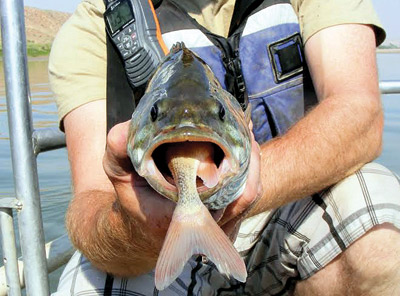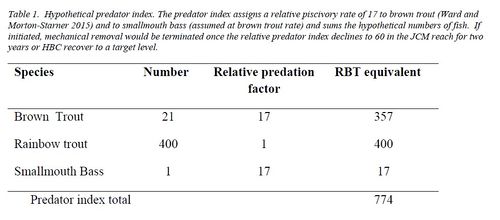|
Ongoing actions:
Reclamation, in collaboration with the NPS and FWS, and in consultation with the
AZGFD, would investigate the possibility of renovating Bright Angel and Shinumo Creeks with a chemical piscicide, or other tools, as appropriate. Additional planning and
compliance, and tribal consultation under Section 106 of the NHPA, would be required.
This feasibility study is outlined in the NPS CFMP (2013; see “Feasibility Study for Use
of Chemical Fish Control Methods”). The action benefits humpback chub and other
native fish by removing nonnative fish that can predate upon and compete with
humpback chub. The regulation and control of nonnative fish is a management action
identified in the Humpback Chub Recovery Goals (USFWS 2002a) and Razorback
Sucker Recovery Goals (USFWS 2002b).
Reclamation would continue to fund efforts of the GCMRC and NPS to remove brown trout (and other nonnative species) from Bright Angel Creek and the Bright Angel Creek
Inflow reach of the Colorado River, and from other areas where new or expanded
spawning populations develop, consistent with the NPS CFMP. After 5 years of removal
efforts are completed (in 2017), an analysis of success would be conducted. Piscicides
may be considered for removal of nonnative species if determined to be appropriate and
following completion of the necessary planning and compliance actions. The regulation
and control of nonnative fish is a management action identified in the Humpback Chub
Recovery Goals (USFWS 2002a) and Razorback Sucker Recovery Goals (USFWS
2002b).
New actions:
Reclamation would explore the efficacy of a temperature control device at the dam to
respond to potential extremes in hydrological conditions due to climate conditions that
could result in nonnative fish establishment. Evaluations would be ongoing for all
current and evolving technological advances that could provide for warming and cooling
the river in both high- and low-flow discharge scenarios, and high and low reservoir
levels. These studies should include evaluating and pursuing new technologies, an
analysis of the feasibility, and a risk assessment and cost analysis for any potential
solutions. The regulation and control of nonnative fish is a management action identified
in the Humpback Chub Recovery Goals (USFWS 2002a) and Razorback Sucker
Recovery Goals (USFWS 2002b).
Reclamation would pursue means of preventing the passage of deleterious invasive nonnative fish through Glen Canyon Dam. Because Glen Canyon Dam release
temperatures are expected to be warmer under low reservoir elevations that may occur
through the LTEMP period, options to hinder expansion of warmwater nonnative fishes
into Glen and Grand Canyons would be evaluated. Potential options to minimize or
eliminate passage through the turbine or bypass intakes, or minimize survival of
nonnative fish that pass through the dam would be assessed (flows, provide cold water,
other). While feasible options may not currently exist, technology may be developed
during the LTEMP period that could help achieve this goal. The regulation and control
of nonnative fish is a management action identified in the Humpback Chub Recovery
Goals (USFWS 2002a) and Razorback Sucker Recovery Goals (USFWS 2002b).
Reclamation would, in consultation with the FWS and AGFD, fund the NPS and
GCMRC on the completion of planning and compliance to alter the backwater slough at River Mile (RM) 12 (commonly referred to as “Upper Slough”), making it unsuitable or
inaccessible to warmwater nonnative species that can compete with and predate upon
native fish, including humpback chub. Depending on the outcome of NPS planning and
compliance, Reclamation would implement the plan in coordination with the FWS,
AGFD, NPS and GCMRC. Additional coordination would be conducted to determine
and access any habitats that may support warmwater nonnatives. The regulation and
control of nonnative fish is a management action identified in the Humpback Chub
Recovery Goals (USFWS 2002a) and Razorback Sucker Recovery Goals (USFWS
2002b).
Reclamation would support the GCMRC and NPS in consultation with the FWS and
AGFD on the completion of planning and compliance of a plan for implementing rapid response control efforts for newly establishing or existing deleterious invasive nonnative species within and contiguous to the action area. Control efforts may include chemical,
mechanical, or physical methods. While feasible options may not currently exist, new
technology or innovative methods may be developed in the LTEMP period that could
help achieve this goal. Rapid response to new warmwater fish invasions may become a
more frequent need in the future with lower reservoir elevations and warmer dam
releases. The regulation and control of nonnative fish is a management action identified
in the Humpback Chub Recovery Goals (USFWS 2002a) and Razorback Sucker
Recovery Goals (USFWS 2002b).
Reclamation, will consider, in consultation with the GCDAMP, the experimental use of TMFs to inhibit brown trout spawning and recruitment in Glen Canyon, or other
mainstem locations. Inhibiting brown trout spawning and recruitment will benefit chub
by reducing the potential for brown trout to predate upon humpback chub. The
regulation and control of nonnative fish is a management action identified in the
Humpback Chub Recovery Goals (USFWS 2002a) and Razorback Sucker Recovery
Goals (USFWS 2002b).
|
Tier 1 Trigger – Early Intervention Through Conservation Actions:
- 1a. If the combined point estimate for adult HBC (adults defined ≥200 mm) in the Colorado River mainstem LCR aggregation; RM 57-65.9) and Little Colorado River (LCR) falls below 9,000 as estimated by the currently accepted HBC population model (e.g., ASMR, multi-state).
-OR-
- 1b. If recruitment of sub-adult HBC (150-199mm) does not equal or exceed estimated adult mortality such that:
- Sub-adult abundance falls below a three-year running average of 1,250 fish in the spring LCR population estimates, or
- Sub-adult abundance falls below a three-year running average of 810 fish in the mainstem Juvenile Chub Monitoring reach (JCM annual fall population estimate; RM 63.45-65.2).
Tier 1 Trigger Response:
- Tier 1 conservation actions listed below will be immediately implemented either in the LCR or in the adjacent mainstem. Conservation actions will focus on increasing growth, survival and distribution of HBC in the LCR & LCR mainstem aggregation area.
Tier 2 Trigger - Reduce threat using mechanical removal if conservation actions in Tier 1 are insufficient to arrest a population decline:
Mechanical removal of nonnative aquatic predator will ensue:
- If the point abundance estimate of adult HBC decline to <7,000, as estimated by the currently accepted HBC population model.
Mechanical removal will terminate if:
- Predator index (described below) is depleted to less than 60 RBT/km for at least two years in the JCM reach and immigration rate is low (the long term feasibility of using immigration rates as a metric still needs to be assessed),
-OR-
- Adult HBC population estimates exceed 7,500 and recruitment of sub-adult chub exceed adult mortality for at least two years.
If immigration rate of predators into JCM reach is high, mechanical removal may need to continue. These triggers are intended to be adaptive based on ongoing and future research (e.g., Lees Ferry recruitment and emigration dynamics, effects of trout suppression flows, effects of Paria River turbidity inputs on predator survival and immigration rates, interactions between humpback chub and rainbow trout, other predation studies).
|

